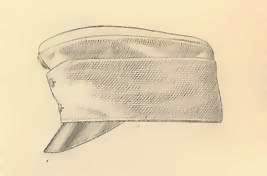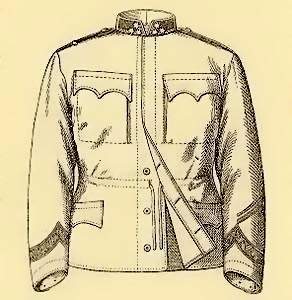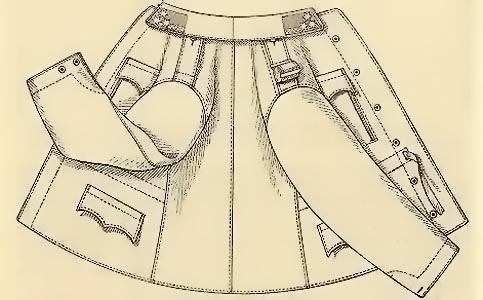

Austrian-Hungarian Common Army Infantry Field Service Uniforms 1914-1918
Introduction
The Austro-Hungarian Army introduced a Pike-Grey or hechtgrau field service uniform for general issue to the infantry arm commencing June 1908 after experimenting for some years with various other shades of material . Until that time the service and field uniform had been a dark blue tunic and blouse respectively. With the introduction of pike grey and later field grey, the former blue uniform was relegated to parade and off duty wear and would continue to be worn by those who possessed it throughout the First World War. The aim of this article is to describe the pike-grey uniform as worn by the Common Army Infantry including the Kaiserjäger, Feldjäger and Bosnian infantry. Although generally speaking the pattern as worn by both commissioned officers and NCOs and private soldiers was very similar they were some subtle differences and also some degree of overlap in the uniform items worn by aspirant officers, deputy officers and the commissioned officers.
Headdress
The most common form of headdress as worn in service dress and in the field was the pike-grey kepi or Kappe. Usually fitted with a black leather peak and fastened at the front by two small buttons. On the centre front of the officers' cap was a bullion circular badge with the Emperor's cypher. Officers and senior aspirant officers (Fähnrich) of Jäger formations also wore additionally a small Jäger horn beneath the bullion badge with distinctions as shown in the following table. The Feldjäger battalions wore the battalion number within the horn. NCOs and private soldiers wore the circular badge in metal:
 |
 |
|
| Bullion Badge | Kaiserjäger Officer | Bosnian Jäger Officer |
For service and off duty wear and especially with the so-called black "salon" trousers, commissioned officers, aspirant officers and deputy officers wore the black Kappe. It would appear from photographic evidence that this cap was also worn in the field contrary to regulations regularly by personnel attached to the air arm of the service. This cap was constructed of black felt and fitted with a black lacquered chin strap and peak. On the top front centre a bullion cockade with the reigning Emperor's cypher surmounted a black and gold double cord which was further decorated with a small regimental button at the lower end. The regulations stipulated that the height of the cap should be between 10cm and 11cm at the front and between 13cm and 14cm at the rear. It can be seen in many wartime photographs that the height of the cap was reduced significantly. The lower edge of the cap was fitted with a double row of gold and black cord to a height of 8mm. The officers and aspirant officers of Jäger units replaced the lower button with a Jäger horn as illustrated above. A pike-grey version of the above headdress was worn by certain groups of officers. It was not a uniform wear item for all officers as is sometimes stated. The following officers were entitled to wear the the pike-grey stiff kepi: General officers, Colonels commanding Brigades, Senior personal Adjutants, Officers of the Military Chancery, General Staff Officers and Officers attached to the General Staff. Identical in all respects apart from the colour, it also had a pike-grey peak and chin strap.
 |
|
| Regulation cut Officers' Kappe | Pike Grey Field Service Kappe |
Although not common, some infantrymen wore a version of the field service Kappe without a peak similar to the cavalry model. The Bosnian-Hercegovinian Infantry Regiments and Jäger battalions wore two versions of the fez.: in red-brown for off-duty and parade wear and in pike-grey for field service wear. The fez was constructed of lambs wool and had a tassel also of lambs wool 18.5cm in length secured to the top of the fez by a cloth rosette. With the red fez, the tassel was black and for the grey fez in grey. The tassel of the officers and Fähnrich was of silk. Non Muslim officers were permitted to wear a standard Kappe.
Jackets
Two basic versions of the "Bluse" or field jacket were introduced for wear in the field: a Summer and a Winter version. Very modern in look the original uniforms were more of a blue-grey similar to the horizon blue of the French Army than to any shade of field grey. The Winter garment was made of basic cloth with six concealed black zinc buttons down the front centre. The jacket was fly fronted with two breast and two hip pockets with scalloped flaps. Badges of rank were worn on patches on a stand collar. Fitted to some but not all blouses was a shoulder roll on the right shoulder to facilitate the carrying of a rifle. Officers' blouses were not fitted with shoulder straps. Photographic evidence would suggest that many Officer Aspirants and Deputy Officers also followed this practice.
 |
 |
| Winter Blouse Front View | Rear View showing fitted shoulder roll |
The Summer version of the field blouse was of exactly the same cut but constructed from linen cloth and had a stand and fall collar:

From 1915 onwards the jackets were produced in various shades of field grey and field green usually with a stand and fall collar and due to supply and production difficulties captured Italian tunics were taken into use.